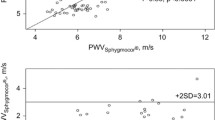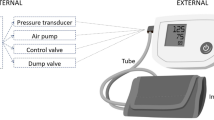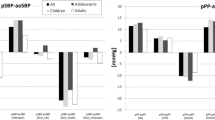Abstract
The oscillometric fixed-ratio method is widely employed for non-invasive measurement of systolic and diastolic pressures (SP and DP) but is heuristic and prone to error. We investigated the accuracy of this method using an established mathematical model of oscillometry. First, to determine which factors materially affect the errors of the method, we applied a thorough parametric sensitivity analysis to the model. Then, to assess the impact of the significant parameters, we examined the errors over a physiologically relevant range of those parameters. The main findings of this model-based error analysis of the fixed-ratio method are that: (1) SP and DP errors drastically increase as the brachial artery stiffens over the zero trans-mural pressure regime; (2) SP and DP become overestimated and underestimated, respectively, as pulse pressure (PP) declines; (3) the impact of PP on SP and DP errors is more obvious as the brachial artery stiffens over the zero trans-mural pressure regime; and (4) SP and DP errors can be as large as 58 mmHg. Our final and main contribution is a comprehensive explanation of the mechanisms for these errors. This study may have important implications when using the fixed-ratio method, particularly in subjects with arterial disease.









Similar content being viewed by others
References
Coleman, A., P. Freeman, S. Steel, and A. Shennan. Validation of the Omron MX3 Plus oscillometric blood pressure monitoring device according to the European Society of Hypertension international protocol. Blood Press Monit. 10(3):165–168, 2005.
Cristalli, C., and M. Ursino. Influence of arm soft tissue on non-invasive blood pressure measurements: an experimental and mathematical study. Measurement 14(3):229–240, 1995.
de Greeff, A., Z. Beg, Z. Gangji, E. Dorney, and A. H. Shennan. Accuracy of inflationary versus deflationary oscillometry in pregnancy and preeclampsia: OMRON-MIT versus OMRON-M7. Blood Press Monit. 14(1):37–40, 2009.
Drzewiecki, G., R. Hood, and H. Apple. Theory of the oscillometric maximum and the systolic and diastolic detection ratios. Ann. Biomed. Eng. 22(1):88–96, 1994.
Geddes, L. A., M. Voelz, C. Combs, D. Reiner, and C. F. Babbs. Characterization of the oscillometric method for measuring indirect blood pressure. Ann. Biomed. Eng. 10(6):271–280, 1982.
Kaihura, C., M. D. Savvidou, J. M. Anderson, C. M. McEniery, and K. H. Nicolaides. Maternal arterial stiffness in pregnancies affected by preeclampsia. Am. J. Physiol. Heart Circ. Physiol. 297(2):H759–H764, 2009.
Longo, D., G. Toffanin, R. Garbelotto, V. Zaetta, L. Businaro, and P. Palatini. Performance of the UA-787 oscillometric blood pressure monitor according to the European Society of Hypertension protocol. Blood Press Monit. 8(2):91–95, 2003.
Marey, E. J. Pression et vitesse dn sang. Masson, Paris: Physiologie Experimentale, vol. 2, cb. VIII, 1876, pp. 307–343.
Mauck, G. W., C. R. Smith, L. A. Geddes, and J. D. Bourland. The meaning of the point of maximum oscillations in cuff pressure in the indirect measurement of blood pressure—Part II. J. Biomech. Eng. 102:28–33, 1980.
Raamat, R., J. Talts, K. Jagomägi, and J. Kivastik. Errors of oscillometric blood pressure measurement as predicted by simulation. Blood Press Monit. 16(5):238–245, 2011.
Richter, H. A., and C. Mittermayer. Volume elasticity, modulus of elasticity and compliance of normal and arteriosclerotic human aorta. Biorheology 21(5):723–724, 1984.
Stang, A., S. Moebus, S. Möhlenkamp, N. Dragano, A. Schmermund, E. M. Beck, J. Siegrist, R. Erbel, K. H. Jöckel, and Heinz Nixdorf Recall Study Investigative Group. Algorithms for converting random-zero to automated oscillometric blood pressure values, and vice versa. Am. J. Epidemiol. 165(7):848, 2007.
Ursino, M., and C. Cristalli. A mathematical study of some biomechanical factors affecting the oscillometric blood pressure measurement. IEEE Trans. Biomed. Eng. 43(8):761–778, 1996.
Vera-Cala, L. M., M. Orostegui, L. I. Valencia-Angel, N. López, and L. E. Bautista. Accuracy of the Omron HEM-705 CP for blood pressure measurement in large epidemiologic studies. Arq. Bras. Cardiol. 96(5):393–398, 2011.
Yelderman, M., and A. K. Ream. Indirect measurement of mean blood pressure in the anesthetized patient. Anesthesiology 50:253–256, 1979.
Acknowledgments
This work was supported by the Telemedicine and Advanced Technology Research Center (TATRC) at the U.S. Army Medical Research and Materiel Command (USAMRMC) through award W81XWH-10-2-0124, a US National Science Foundation CAREER Grant [0643477], and the Natural Sciences and Engineering Research Council of Canada (NSERC).
Conflicts of interest
None.
Author information
Authors and Affiliations
Corresponding author
Additional information
Associate Editor Joan Greve oversaw the review of this article.
Jiankun Liu and Jin-Oh Hahn are equally contributing first authors.
Rights and permissions
About this article
Cite this article
Liu, J., Hahn, JO. & Mukkamala, R. Error Mechanisms of the Oscillometric Fixed-Ratio Blood Pressure Measurement Method. Ann Biomed Eng 41, 587–597 (2013). https://doi.org/10.1007/s10439-012-0700-7
Received:
Accepted:
Published:
Issue Date:
DOI: https://doi.org/10.1007/s10439-012-0700-7




